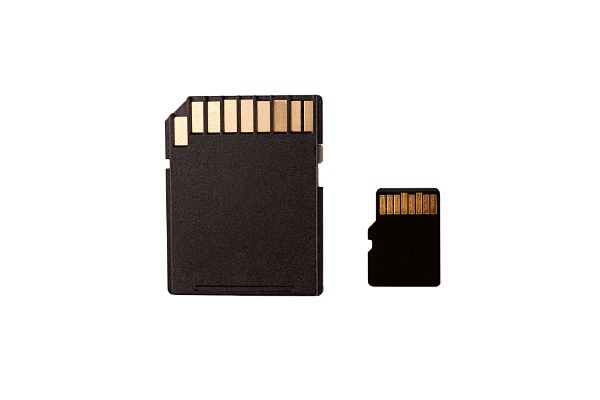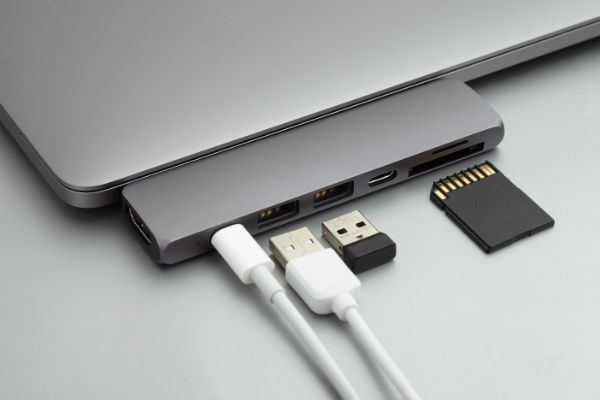Disclaimer: This post may contain affiliate links, meaning we get a small commission if you make a purchase through our links, at no cost to you. For more information, please visit our Disclaimer Page.
Secure Digital (SD) cards are small memory cards used for computers. You might have used one in the past, like in an old digital camera, to transfer photos between devices. Though some think they don’t need SD cards anymore, your laptop can still benefit from them.
Table of Contents
Types of SD Cards
In the 1990s, many laptops and other devices used a MultiMediaCard (MMC). Then, Sony came up with the Memory Stick to help consumers. It led to the later release of the CompactFlash card.
However, those cards almost disappeared overnight with the introduction of the SD card, which hit the market in 1991. Not only was it smaller than the other cards, but many also found it easier to use. In addition, SD cards can store up to 2GB of data.
Other Memory Cards
Secure Digital High Capacity (SDHD) cards emerged in 2006 and quickly became popular among computer users. This card is compatible with faster systems and can store up to 32GB of data.
Secure Digital eXtended Capacity (SDEC) cards arrived in 2009. Though roughly the same size as other cards, it has a capacity of 2TB. You’ll also find Secure Digital Ultra Capacity (SDUC) cards that hold 128 TB of data.
SD Card Uses
The most common reason to use an SD card is its extra memory. Cheaper computers usually do not have as much hard drive space as others do. Plus, it can take a lot of money and time. You also risk damaging your computer if you’re unfamiliar with the process.
SD cards were once so popular that Dell and other brands made laptops with built-in card readers. Using one is as easy as removing the card from your camera or other device and sliding it into the SD reader. Most of these laptops placed the reader on the front.
Few devices today use SD cards because new technology is available. In addition, some brands stopped making them because they are susceptible to viruses. That they then carry and affect other devices. They can also fail for various reasons.
Instead, buy a mini SD card or an SD card from an electronics store. The mini cards are small enough to fit in a tablet or phone but give you much more memory. There are also different types of adapters that work with these cards.
One is a small case that wraps around the mini card to make it the same size as an SD card. The other is similar to a USB hub in that it has a slot where you insert the card to make your system read it.
Data Transfer
Have you ever wanted to move files from your laptop to your desktop? Maybe you have a computer you use at home and need to send files to your work computer. You can email the files, but this takes a lot of time. Using cables is another option, but it’s easy to trip over them and disrupt the transfer.
An SD card is a convenient way to transfer data between two devices or systems. With an SD card, you insert it and choose the files you want to save on it.
Many systems even allow you to drag and drop those files. As a bonus, your computer should instantly recognize the card. Once you remove it, insert the card into the other computer to transfer the files.
You can use an SD card in the same way you would a thumb drive.
SD cards also allow you to transfer data between devices, such as gaming consoles and cell phones.
If you have a mini SD card in your phone, you should invest in an adapter to ensure your computer can read it. Many consoles have slots on the back or side that allow you to insert a memory card. It comes in handy if you want to save your game progress or when you want to access your game on a different system. You can also use an SD card to transfer photos and videos you took with your camera to your computer.
Backup Storage
Few things are worse than turning on your laptop and seeing an error message that stops it from working. Corruption within the Operating System (OS) can cause a hard drive failure that keeps you from accessing your files. While there is a chance that tech can recover your files and get your laptop running again, you cannot guarantee this will happen.
Many people who experienced hard drive failure in the past find ways to back up their files. An SD card allows you to save copies of the files and folders on your hard drive. You should back up your files at least once a month, but you may want to do it more often.
Once you move copies of the files to the card, store them in a safe spot. Most brands include plastic cases that protect their cards from dust and moisture. Keep the card in a place you can easily remember and access.
Formatting an SD Card
Whether you buy a new SD card or want to use an old one you found, you need to format it first. Formatting an old card removes any stored data and gives you more space. Always review the files first to ensure you don’t need or want them. Formatting a new card is also essential because you want to remove any errors it might have and ensure it can work with your laptop.
To format your card:
- Insert it into your laptop.
- Open your settings and go to Windows File Explore to select This PC. If you do not see This PC, choose My Computer.
- Look under the “Devices” and “Drives” to find the SD card.
- Right-click on the card’s icon, pick the Manage option, and then the Format option.
Using the Quick Format choice allows your laptop to format the card for you.
If you have a Mac, insert your SD card and open the Finder. Enter the “Utilities” folder and pick the Disk Utility. You can then choose your card and the Erase feature. Make sure you select the correct format option and then let the Mac erase the data on the card.
Why Can’t You Format Your Card?
You might have difficulty formatting your SD card because of an error. Corruption is one of the more common problems, especially if you have an old card.
How you store it is crucial to how long it will last. High or low temperatures can easily corrupt these cards. When you insert the card and follow the above steps, you should get a message that lets you know you formatted the card.
Try moving all the files from the card to your laptop and then deleting them. It should fix the problem if there is a corrupted file on the card. After that, try a few different things to improve the SD card.
How to Fix a Corrupted SD Card
Look for write protection on the card before you do anything else. Manual protection is standard on new cards and may include a small piece of adhesive paper that keeps your laptop from reading the card until you remove it. This piece of paper can also stick to the side of the card.
Some cards come with write protection that requires software removal. You need to go into “Utilities” and select the card. Different brands have different steps you need to follow to remove that protection.
How to Read an SD Card on a Laptop
Reading and using an SD card on your laptop is easy if you have a memory card slot. Some models have a place right on the front, but you might find that your notebook has a space on the back or the side.
Keep in mind that this slot should have a plastic piece that is the same size and shape as a memory card. You need to lightly push in on the card until you hear a click, which will cause it to come out. Once you remove the plastic, you can insert your SD card.
SD cards are common in tablets, laptops, and notebooks because they don’t add much weight to the device but can hold a lot of memory. In addition to SD card slots, some computers have smaller slots designed for mini or micro SD cards. Pick up an adapter and a standard slot if you have smaller SD cards.
These adapters hold micro and mini SD cards and put the chip near the front where your laptop can find it. When you insert the adapter, your computer will read it as quickly as it reads standard SD cards.
I Don’t Have a SD Card Slot. What Should I Do?
Many people buy new laptops without checking whether they have an SD slot. You do not need to worry because there are good alternatives to those slots, such as a USB hub.
USB hubs come in designs that you plug into a USB port on your laptop. Others have an AC adapter that works with a wall outlet. They have multiple USB slots as well as other ports.
Many models also have a card reader that works with SD cards. When you connect the hub to your laptop and insert your card, you can view the files on your screen.
A USB card reader is another easy way to view the data. These readers are compact enough to carry. They have a dedicated slot for your card and a USB cord that plugs into your laptop.
Once you plug it in, wait for your system to find and recognize it. You can then add your card and bring it up on your screen. It lets you transfer any files you want to keep and delete old files and see what data is on the card.
You can also use an SD card adapter, which comes with either a USB-C or a USB-B adapter. Not only are these pretty handy, but they are also relatively cheap.
Though it looks like a standard thumb drive, it has two plastic caps that pop off. Remove one and insert your SD card into the side. Then, remove the other to plug the adapter into your laptop. Snag one that uses different adapters on each side is often helpful because you can use them with more devices.
Conclusion
An SD card gives you more memory for your laptop and a handy backup for your system. You can also use one to transfer data, even if you don’t have a dedicated card slot. Use a new or old SD card to get more out of your laptop.


